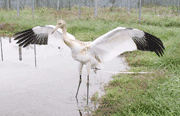Florida Ill Winds Blast Endangered Cranes
Whooping cranes raised at Laurel perish in tornado
by Dotty Holcomb Doherty
Seventeen young whooping cranes drowned in their pens in a storm surge last week, victims of the same Florida tornado that killed 20 people.
These were babies raised in Maryland in a determined effort to bring this species back from extinction.
For the past 30 years, Patuxent Wildlife Research Center in Laurel reared baby whooping cranes, a species that hit a wild population low of 21 in 1941. Concerted efforts have increased the population to over 350 wild birds, plus about 145 in captivity.
Now 17 of this year’s 18 fledglings are gone.
The drowned birds, all but one of the 2006 class, hatched from eggs supplied by five partners in the recovery effort: Patuxent’s own captive whoopers, the Calgary Zoo, the International Crane Foundation, Necedah National Wildlife Refuge and the Audubon Species Survival Center.
The lone survivor, 15-06 (the 15th chick hatched at Patuxent in 2006) from a Patuxent captive pair, escaped to a nearby prairie with sandhill cranes and whoopers from the class of 2005.
“These birds were the start of a new generation of life for the species,” says John Christian, co-chair of the Whooping Crane Eastern Partnership. “My heart is aching both for the young birds we lost and for the dedicated people who have devoted so much of themselves. But we will recover and continue our work.”
Much of that work goes on at Patuxent Wildlife Research Center, where crane managers disguise themselves as cranes to teach the young birds to live in the wild.
An ultralight plane trains the fledglings to migrate. At Patuxent, they toddle behind the taxiing plane, taking first steps in becoming a migratory flock. Training continues at Wisconsin’s Necedah National Wildlife Refuge. When their flight feathers grow in, they practice flying behind the ultralight, until early October when an Operation Migration pilot leads them to Florida.
Over the last seven years, 80 whooping crane fledglings have followed this mechanical surrogate on the 76-day trek — which includes 22 flying days —traveling 1,200 miles to the Chassahowitzha National Wildlife Refuge. Come spring, the wild cranes migrate back to Wisconsin on their own.
This spring, only one crane from the class of 2006 will make that return trip.
